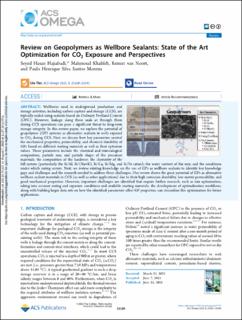| dc.contributor.author | Hajiabadi, Seyed Hasan | |
| dc.contributor.author | Khalifeh, Mahmoud | |
| dc.contributor.author | Van Noort, Reinier | |
| dc.contributor.author | Silva Santos Moreira, Paulo Henrique | |
| dc.date.accessioned | 2023-08-23T11:58:42Z | |
| dc.date.available | 2023-08-23T11:58:42Z | |
| dc.date.created | 2023-08-07T13:24:53Z | |
| dc.date.issued | 2023-06 | |
| dc.identifier.citation | Hajiabadi, S.H., Khalifeh, M., van Noort, R., Santos Moreira, P.H.S. (2023) Review on Geopolymers as Wellbore Sealants: State of the Art Optimization for CO2 Exposure and Perspectives. ACS Omega, 8 (26), 23320-23345. | en_US |
| dc.identifier.issn | 2470-1343 | |
| dc.identifier.uri | https://hdl.handle.net/11250/3085450 | |
| dc.description.abstract | Wellbores used in underground production and storage activities, including carbon capture and storage (CCS), are typically sealed using sealants based on Ordinary Portland Cement (OPC). However, leakage along these seals or through them during CCS operations can pose a significant threat to long-term storage integrity. In this review paper, we explore the potential of geopolymer (GP) systems as alternative sealants in wells exposed to CO2 during CCS. First, we discuss how key parameters control the mechanical properties, permeability, and chemical durability of GPs based on different starting materials as well as their optimum values. These parameters include the chemical and mineralogical composition, particle size, and particle shape of the precursor materials; the composition of the hardener; the chemistry of the full system (particularly the Si/Al, Si/(Na+K), Si/Ca, Si/Mg, and Si/Fe ratios); the water content of the mix; and the conditions under which curing occurs. Next, we review existing knowledge on the use of GPs as wellbore sealants to identify key knowledge gaps and challenges and the research needed to address these challenges. Our review shows the great potential of GPs as alternative wellbore sealant materials in CCS (as well as other applications) due to their high corrosion durability, low matrix permeability, and good mechanical properties. However, important challenges are identified that require further research, such as mix optimization, taking into account curing and exposure conditions and available starting materials; the development of optimalization workflows, along with building larger data sets on how the identified parameters affect GP properties, can streamline this optimization for future applications. | en_US |
| dc.language.iso | eng | en_US |
| dc.publisher | American Chemical Society | en_US |
| dc.rights | Navngivelse 4.0 Internasjonal | * |
| dc.rights.uri | http://creativecommons.org/licenses/by/4.0/deed.no | * |
| dc.subject | kjemi | en_US |
| dc.title | Review on Geopolymers as Wellbore Sealants: State of the Art Optimization for CO2 Exposure and Perspectives | en_US |
| dc.type | Peer reviewed | en_US |
| dc.type | Journal article | en_US |
| dc.description.version | publishedVersion | en_US |
| dc.rights.holder | © 2023 The Author(s). | en_US |
| dc.subject.nsi | VDP::Matematikk og Naturvitenskap: 400::Kjemi: 440 | en_US |
| dc.source.pagenumber | 23320-23345 | en_US |
| dc.source.volume | 8 | en_US |
| dc.source.journal | ACS Omega | en_US |
| dc.source.issue | 26 | en_US |
| dc.identifier.doi | 10.1021/acsomega.3c01777 | |
| dc.identifier.cristin | 2165297 | |
| dc.relation.project | EC/H2020/691712 | en_US |
| cristin.ispublished | true | |
| cristin.fulltext | original | |
| cristin.qualitycode | 1 | |

